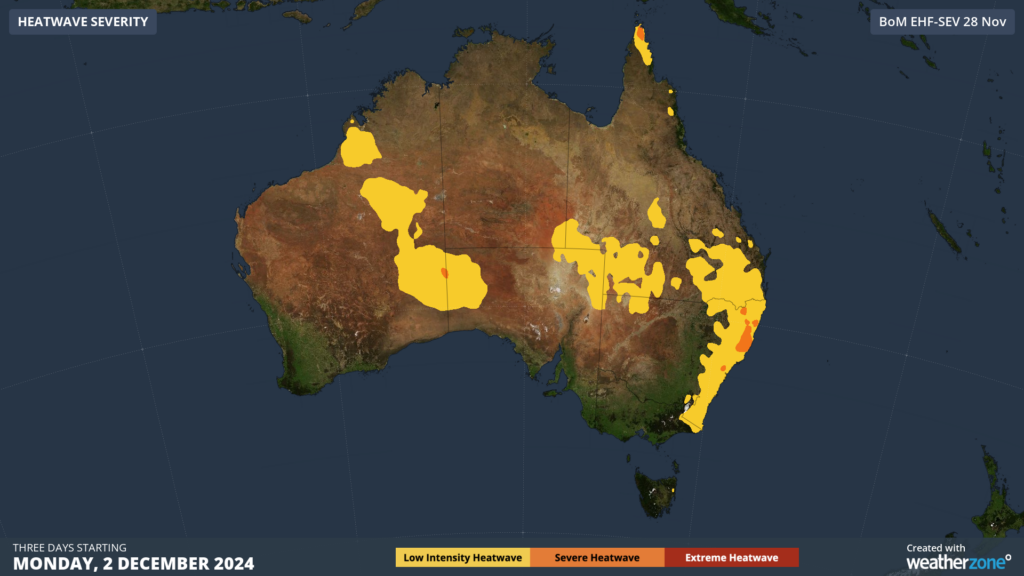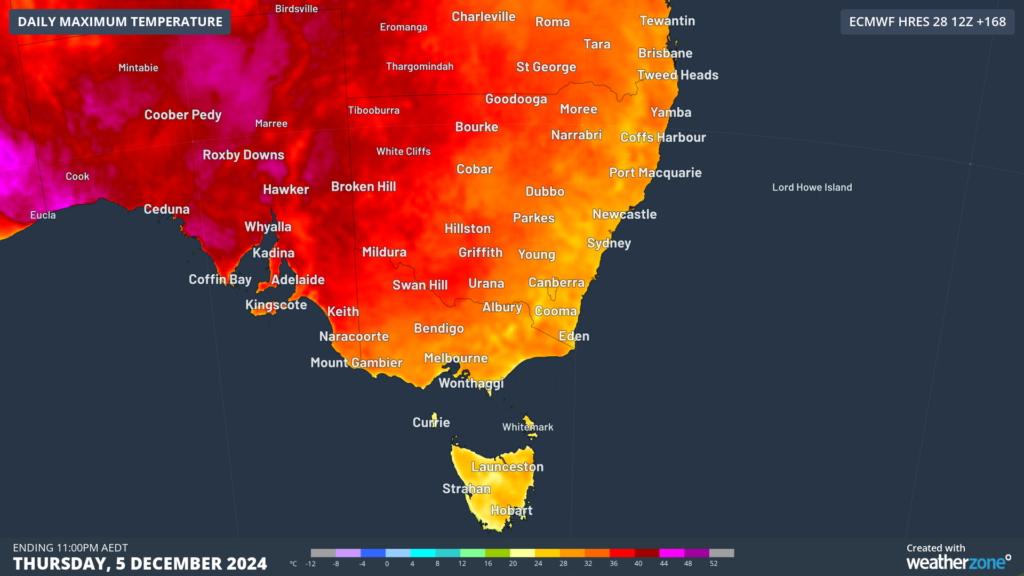The first week of summer is set to arrive with a bang, with hot and humid conditions expected for at least five states and territories next week.
A blocking high pressure system in the Tasman Sea will direct hot northerly winds across southeastern Australia for much of next week.
This slow pattern will allow heat to build over the region for several days with heatwave conditions forecast for parts of SA, Vic, Tas, the ACT, NSW and Qld from Monday, December 2. Severe heatwave conditions are again forecast for parts of NSW next week, with temperatures forecast to soar across the state.

Image: Heatwave severity forecast for the three days beginning on Monday, December 2. Source: BOM
There are early signs that western Sydney could endure temperatures in the 30s for the first week of summer, meanwhile the east is forecast to see temperatures remaining in the high 20s to low 30s.
Adelaide and Melbourne both will reach the low 30s on Monday, December 2, with Melbourne possibly seeing a second day of low 30s on Tuesday before a cold front and northwest cloud band cool the region down. This change will be relatively shallow, and temperatures will bounce back quickly mid to late next week.
The second round of heat will pack a punch, with temperatures soaring into the 40s across parts of SA on Thursday and Friday.

Image: Maximum temperature forecast for Thursday, December 3, according to ECMWF
At this stage Adelaide is forecast to reach 37°C on Thursday, with Melbourne forecast to top at 32°C.
Tropical moisture will also feed into southeastern Australia next week, bringing uncomfortably humid conditions to the region along with the heat. The sticky conditions could make the temperature feel 3 to 5 degrees hotter than the actual temperature.
The hot and humid conditions will be combined with uncomfortably warm nights across southeastern Australia as tropical moisture feeds into the region.
Sydney will fail to see temperatures drop below 20°C in the next week, while Brisbane’s minimum is forecast to be around 22 to 23°C.
The warm nights will make it hard for people to sleep and recover from the days’ oppressive heat, so be sure to keep cool.
DTN APAC supplies precise weather intelligence to over 75% of the National Energy Market (NEM); and is the trusted provider for the Australian Energy Market Operator (AEMO).
Weatherzone’s next-generation nowcasting and forecasting system, OpticastTM, is independently proven to outperform other industry models, allowing energy traders to respond rapidly to changing conditions. From 14 day forecasting to seasonal outlooks, you have access to complete and powerful weather intelligence giving you the confidence to make the best call.
Meeting the needs of the changing market, Weatherzone utilises high-resolution modelling and local knowledge to provide 5-min granularity observations and forecasts, optimising your market bidding and maximising your profits. These, coupled with briefings from our energy meteorologists, give you full awareness of the associated risk.
Benefit from specialised indices such as apparent temperature, Cooling/Heating Degree Days (CDD/HDD) and Effective Degree Days (EDD) to help accurately predict demand. You can get a clear picture of forecast conditions across the market and quickly assess heat/heatwave potential from 14 days out to 12 months
No matter where your energy trading focus lies, we have the power generation and weather insights to inform your critical decisions, keeping you ahead of the curve. For more information please visit our website or email us at sales.apac@dtn.com.






